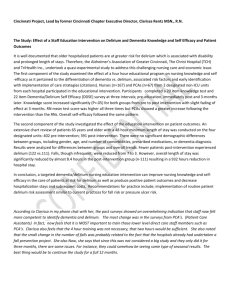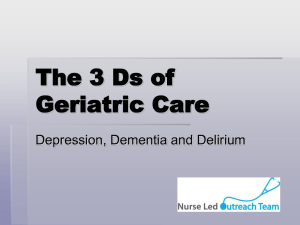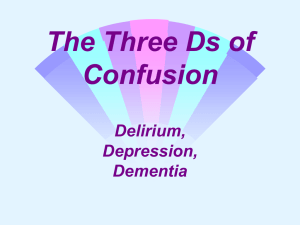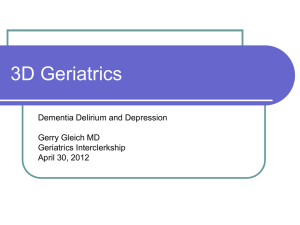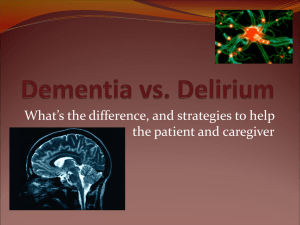A Starter Kit to Teaching Mental Health
advertisement
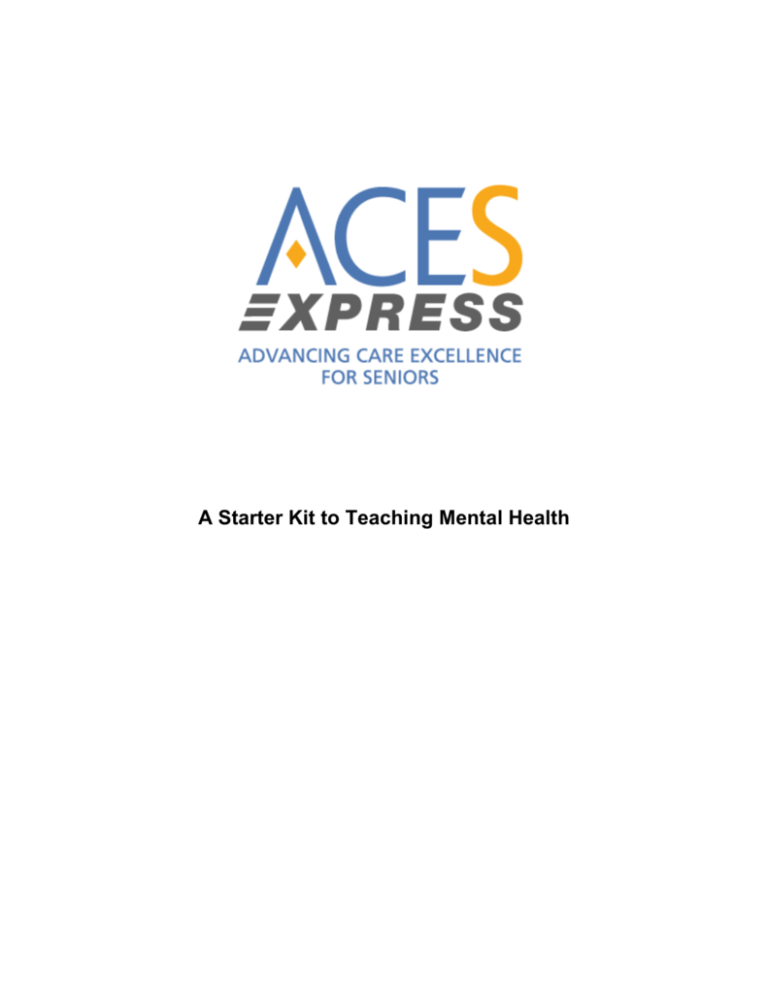
A Starter Kit to Teaching Mental Health Mental Health Table of Contents Introduction Teaching Strategy I: The Impact of Comorbidity of Depression and Anxiety on Outcomes of Illness Overview of Teaching Strategy............................................................................................................................... 1 Getting Started........................................................................................................................................................ 2 Materials ................................................................................................................................................................. 3 Suggested Readings .............................................................................................................................................. 4 Author Information .................................................................................................................................................. 4 Teaching Strategy II: Recognizing Dementia, Depression, and Delirium in Older Adults Overview of Teaching Strategy............................................................................................................................... 5 Getting Started........................................................................................................................................................ 5 Materials ................................................................................................................................................................. 6 Author Information .................................................................................................................................................. 7 Unfolding Case: George Palo Overview of Unfolding Case ................................................................................................................................... 8 Simulation Scenerios 1, 2, and 3 ............................................................................................................................ 8 Author Information ................................................................................................................................................ 10 Additional ACE.S Resources Mental Health Introduction Research shows that less than one fifth of nurse faculty teaching in associate degree programs and less than one half of the faculty teaching in bachelor degree programs are prepared to provide students with a solid education in caring for the vast majority of older adults throughout our country’s communities. Thus, a majority of undergraduate nurse faculty have limited knowledge of or experience with the emerging body of knowledge related to the care of older adults and their mental health. ACESXPRESS is a free digital resource series developed to provide concise the Advancing Care Excellence series and implementation strategies and opportunities for peer-to-peer communication and collaboration regarding teaching care of older adults. Through ACESXPRESS, the NLN and its strategic partners seek to foster a rich ongoing conversation among a diverse community of educators invested in improving care for this vulnerable population. Educating faculty is the key to assuring that new nurses care properly for older patients. ACE.S is the go-to gerontological resource hub for accessing classroom-ready teaching tools and strategies. It has a wealth of information about upcoming faculty development events related to integration of care of older adults into nursing program curricula. Mental Health Teaching Strategy I The Impact of Comorbidity of Depression and Anxiety on Outcomes of Illness Overview of Teaching Strategy The impact depression and anxiety can have on outcomes of medical procedures and illness is significant. Older adults do not always present in the same way as a younger population regarding symptoms related to these illnesses. It is not uncommon for health care professionals to miss or ignore a diagnosis of depression or anxiety because they feel the symptoms are fully explained by the situation. A missed diagnosis can have detrimental effects on outcomes, transition back home, and return to functioning. In this Teaching Strategy the student will meet Eugene Shaw, an 82 year old former marine who served in the Korean War. This teaching strategy focuses on Eugene's hospitalization for vascular problems related to his diabetes and subtle hints that he may have an underlying depression or anxiety. The activities are directed at evaluating, and better understanding, the complexities of these diagnoses compounded with his medical problems. In addition the student will explore the general impact of stress, depression and anxiety on outcomes when seen in concert with chronic illness. Learning Outcomes The student will: Identify behaviors that may indicate a mood disorder Identify behaviors that may indicate anxiety Develop an understanding of the difference between depression and difficulty coping Identify tools that could be useful in assessing cognition and mood Demonstrate an understanding of the impact of depression and anxiety on outcomes of physical illness ACES Essential Nursing Actions Assess Function and Expectations Coordination and Management of Care Make Situational Decisions ACES Essential Knowledge Domains Individualized Aging Vulnerability During Transitions Complexity of Care NLN Education Competencies Mental Health Nursing Judgment Human Flourishing Spirit of Inquiry Getting Started 1. Listen to Eugene in this monologue or download the printed copy of the monologue. As you listen to Eugene, think about the following questions and be prepared to discuss them. What evidence do you hear that may be indicative of depression? How can you assess Eugene's baseline functional status? What coping strategies does Eugene use? Who are Eugene's support system and how can they help him? What evidence of anxiety do you hear as Eugene talks? What are Eugene's strengths and weaknesses? What else do you want to know about Eugene? What is your impression of Eugene’s relationships? 2. Consider what assessment tools would be appropriate for continuing to evaluate Eugene. Utilize these tools to better understand: The behaviors associated with Major Depression Evidence of any cognitive impairment that may be complicating Eugene's recovery The overlap of depressive, cognitive and anxiety behaviors and what they mean How alcohol may be a factor in compromising outcomes What is Eugene's baseline level of functioning and has he deviated from that point? How can you evaluate Mrs. Shaw’s ability to manage the caregiving role? 3. A concept map is a diagram that illustrates relationships among concepts. Assign a concept map to students after they listen to the monologue or have the students do a concept map as a group project in class/seminar, or as a post-conference activity. In the third scenario of the simulation, Eugene is recovering from surgery. Introduce this snapshot of his life to the students as they develop the concept map. This activity allows students to see the repercussions of depression especially in the older adult recovering from surgery. See the example of a draft of a concept map in the materials section. In completing this exercise students should consider: What is depression? What are the causes for depression? What are the symptoms of depression? What are the pharmacological treatments for depression? Will these treatments impact any other treatments the patient may be getting? What are the non-pharmacological treatments for depression? 4. Investigate the resources available to Veterans on the AARP Caregiver Resource page http://www.aarp.org/home-family/voices/veterans/info-2015/military-veterans-caregivers-support.html Materials Mental Health 1. ConsultGeriRN.org; the website of the Hartford Institute for Geriatric Nursing at New York University's College of Nursing contains many evidence-based assessment tools. Those listed below from the Try This® and How to Try This Series® focus on tools that would help in assessing a client like Eugene. Try This Issue 1 SPICES- An Overall Assessment of Older Adults Try This Issue 3 Mental Status Assessment of Older Adults Mini Cog Try This Issue 4 Geriatric Depression Scale Try This Issue 14 the Modified Caregiver Strain Index Try This Issue 17 Alcohol Use and Screening Assessment 2. Click onto this file that contains the draft of a sample concept map illustrating the concept of depression. Please note that this is only a sample and not inclusive of all of the connections between depression and functioning. It should be used only as a draft and not considered a complete concept map related to the Eugene Shaw case. Suggested Readings Smith, M., Haedtke, C., & Shibley, D. (2015). Evidence-based practice guideline: Late-life depression detection. Journal of Gerontological Nursing, 41(2), 18-25. Grady, Patricia A, PhD,R.N., F.A.A.N., & Rosenbaum, L. M., PhD. (2015). The science of caregiver health. Journal of Nursing Scholarship, 47(3), 197-199. McGrandles, A., & Duffy, T. (2012). Assessment and treatment of patients with anxiety. Nursing Standard, 26(35), 48-56; quiz 58. Author Information Laureen Tavolaro-Ryley, MSN, RN Community College of Philadelphia, PA lryley@ccp.edu Mental Health Teaching Strategy II Recognizing Dementia, Depression, and Delirium in Older Adults Overview of Teaching Strategy Dementia, depression, and delirium are among the most common psychiatric disorders seen with older adults and speak to the complexity of the specialty of geriatrics. The overlap of symptoms prevalent in this triad is abundant. The ability to differentiate the subtle differences is vital to optimum outcomes to older adults. Understanding the differences and putting the proper interventions into place helps to ensure the best outcomes. Adding to the complexity of dementia, depression, and delirium is the very real possibility of having a combination of these issues; even all three concurrently. Mortality and morbidity rates increase with delirium with mortality rates from 22-76 percent in hospitalized patients and rates as high as 40 percent one year after diagnosis of delirium (Inouye, 2006). The possible cascade of negative outcomes, which can result from any combination of this trio, can cumulate into a significant alteration in the quality of life of an older adult. This teaching strategy is designed to help students understand dementia, depression, and delirium. By better understanding this triad and developing a clearer understanding of the similarities and differences, the student will be better able to intervene to ensure the best outcomes. This strategy utilizes active learning to help students understand the content and to apply it to clinical practice. Learning Objectives Students will: Develop an understanding of behaviors associated with Alzheimer’s dementia Develop an understanding of the etiology of the behaviors Articulate an assessment of behavioral disturbances v. aggressive behaviors Recognize the risks associated with caregiver burnout with behavioral issues Create a tool box of approaches to intervening with the client with behavioral issues related to Alzheimer’s dementia Better understand the use of standardized tools in evaluating both behaviors and the etiology of behaviors Articulate possible safety concerns as they pertain to the behaviors discussed ACES Essential Knowledge Domains Complexity of Care Individualized Aging Vulnerability During Transitions ACES Essential Nursing Actions Assess Function and Expectations Use Evolving Knowledge Coordinate and Manage Care NLN Competencies for Nursing Education Mental Health Nursing Judgment Spirit of Inquiry Getting Started 1. Download the PowerPoint document labeled Is It Dementia, Depression, or Delirium Game . The document is a power point presentation of a game students can play, directed by a faculty facilitator. This strategy promotes active learning as the platform to discuss dementia, depression, and delirium. The speaker’s notes have additional information for the facilitator to continue the discussion. These notes also link to applicable tools that are pertinent to the content. It may be helpful to assign students a reading from their text books or prepare by reading an article such as: Edwards, N. (2003). Differentiating the three D's: Delirium, dementia, and depression. Medsurg Nursing, 12(6), 347-57; quiz 358. a) The PowerPoint presentation needs to be viewed in slide show mode to play. b) Click to advance the slides to the next question, and double click to reveal the answer choices, then single click to reveal the correct answer. Repeat this to go through all fourteen questions. c) There are points assigned to each question if the facilitator chooses to use the game in a competitive manner. d) The slides can be edited at the discretion of the facilitator to include any additional information. 2. All of the simulation cases; Ertha Williams, Judy Jones and George Palo have elements of dementia, depression, and delirium and can be used in an active way to help students identify differences and interventions. These simulations can be utilized after the students play the game; Is It Dementia, Depression, or Delirium or independent of the game. In addition, any of the monologues could be used at the start of a lecture to spark discussion and have the students link the content to a first-person case study. These monologues can also be a dynamic part of an online discussion on dementia, delirium, and depression as the instructor can guide the learner to the audio clip of the case. In each case the patients have a level of confusion with an array of other symptoms that require the student to think about how they would further assess the patient and what interventions they would put into place based on the diagnosis and behavioral concerns. a) Judy Jones has an underlying dementia with a superimposed delirium resulting in an acute change in mental status and behavioral changes. b) George Palo has a mild cognitive impairment with worsening of cognitive impairment with a superimposed depression. c) Ertha has progressive Alzheimer’s dementia with worsening of her symptoms with time and transition. d) Utilize the Confusion Assessment Method in each of these simulation monologues to start the discussion on the differentiation between dementia and delirium: e) Tool - Video f) Utilize the following questions (Benner) to help further process the content in monologues: Mental Health What are your concerns about this patient? What is the cause of the concern? What information do you need? What are you going to do about it? What is the patient experiencing? Materials 1. Recognition of Dementia in Hospitalized Older Adults Tool Video 2. Mental Status Assessment of Older Adults: The Mini-Cog TM Tool Video 3. Assessing and Managing Delirium in Older Adults with Dementia Tool Video 4. Geriatric Depression Scale Tool Video 5. Alzheimer’s Association Dementia and Delirium: Do you know the Difference? 6. Mental Status Assessment in Older Adults: Montreal Cognitive Assessment MoCA Version 7.1: http://consultgerirn.org/uploads/File/trythis/try_this_3_2.pdf 7. The AD8: The Washington University Dementia Screening Test. Eight-Item Interview to Differentiate Aging and Dementia: http://consultgerirn.org/uploads/File/trythis/try_this_d14.pdf Suggested Readings Bradway, C., Bixby, M. B., Hirschman, K. B., McCauley, K., & Naylor, M. D. (2013). Case study: Transitional care for a patient with benign prostatic hyperplasia and recurrent urinary tract infections. Urologic Nursing, 33(4), 177-9, 200. Edwards, N. (2003). Differentiating the three D's: Delirium, dementia, and depression. Medsurg Nursing, 12(6), 347-57; quiz 358. Delirium Superimposed on Dementia: Accuracy of Nurse Documentation Steis, Melinda R., PhD, RN; Fick, Donna M., PhD, RN, FAAN. Journal of Gerontological Nursing 38.1 (Jan 2012): 32-42. Wang, C., Wu, Y., Yue, P., Ely, E. W., Huang, J., Yang, X., & Liu, Y. (2013). Delirium assessment using confusion assessment method for the intensive care unit in chinese critically ill patients. Journal of Critical Care, 28(3), 223-9. Mental Health References Benner, P., Sutphen, M., Leonard, V., Day, L., & Shulman, L. (2010). Paradigm case: Lisa Day, classroom and clinical instructor. In Educating nurses: A call for radical transformation (p. 133). San Francisco: Jossey-Bass. Inouye SK. (2006). Delirium in older persons. N. Engl. J. Med. 2006;354:1157–1165. Author Information Laureen Tavolaro-Ryley MSN, RN Community College of Philadelphia, PA lryley@ccp.edu Mental Health Unfolding Case: George Palo Overview: George Palo is a 90-year-old male who has been diagnosed with early stage dementia. George's wife Anna died two years ago and he moved into a small one-bedroom apartment in a retirement community, independent living setting. George has five children, but only his oldest daughter Maggie lives nearby. George has been relatively healthy over his long life with the exception of high blood pressure which is controlled with medication. He is very independent and loves to be outdoors, walking his golden retriever, Max. Maggie and her siblings are trying to support their dad's independence as long as possible, but are cognizant of his age and concerned about his overall safety. Monologue: George discusses his journey through widowerhood and the experience of losing his home when he moved to the retirement community. He is grateful that his family was able to find a place that allowed him to keep his 13-year-old golden retriever Max. George relates how he and his wife, Anna, were actively involved in their local humane society and how they adopted Max as a puppy. He takes great pride in his independence and admits he is quite stubborn and not very accepting of help from others, especially strangers. He is unaware that he is getting more forgetful and often repeats himself during the monologue. He appreciates the help that his daughter Maggie provides, and is concerned about making too many demands on her time. George is passionate about sustaining his independence and is adamant about never going to a nursing home. George's Introductory Monologue Download an audio file. Download the script for the audio file. Download Instructor Toolkit ideas for use with George's introductory monologue Simulation Scenario 1 The resident nurse for the retirement community conducts a weekly blood pressure clinic. Three weeks ago, she found a marked increase in George's blood pressure. George became annoyed when she asked if he was taking his medications. George has not returned for the past two weeks so the nurse contacted George's daughter Maggie, who reported other behavioral changes. Together they arrange to have a community health nurse visit George to conduct an assessment. This nurse will be expected to use appropriate tools to assess his cognition and to suggest to both Maggie and George some ways to support George in maintaining his function and independence. Download Simulation 1 Template Download chart materials appropriate for Simulation 1 Simulation Scenario 2 It is three months later. George was evaluated by his primary physician, who found that his diagnosis has progressed from mild cognitive impairment to mild dementia, Alzheimer's type, and started George on Galantamine. His blood pressure is back under control and he seemed to be managing well until a few weeks ago when Max, George's 13-year-old golden retriever died. Maggie asks the community health nurse to make another visit. During this visit, the nurse will be expected to use appropriate tools Mental Health to assess his depression, provide emotional support for his loss, reassess his cognition and discuss adjustments in his activities that can help to maintain his optimal level of function and independence. Download Simulation 2 Template Download chart materials appropriate for Simulation 2 Simulation Scenario 3 Three more months have passed. George fell and sustained a femoral neck fracture that was repaired with an open reduction and internal fixation. He has just been discharged and is staying at Maggie's house with physical therapy ordered daily and visits by the community health nurse twice a week. This scenario takes place during the first visit by the nurse. The nurse will be expected to do a physical and functional assessment, review his medications, and reassess his cognition. The nurse will also contact the physical therapist, use the SBAR technique to report findings, and collaborate on criteria and goals for George's return to his apartment. Download Simulation 3 Template Download chart materials appropriate for Simulation 3 Finish the Story Assignment Learners have now seen George at three snapshots in time. What do they think his life will be like three months from now? Click here for ideas on how this assignment could be implemented Click here for Instructor Toolkit ideas for use with all simulations Author: Susan Gross Forneris, PhD, RN, CNE, CHSE-A National League for Nursing Mental Health Advancing Care Excellence is an ongoing NLN initiative to improve the quality of care for vulnerable populations. Thanks to the John A. Hartford Foundation, Laerdal Medical, the Independence Foundation, Hearst Foundations, Independence Blue Cross Foundation, MetLife Foundation, and Community College of Philadelphia, the NLN Center for Excellence in the Care of Vulnerable Populations houses ACE programs for seniors (ACE.S), veterans (ACE.V), and Alzheimer’s patients (ACE.Z). ACE programs provide free classroom-ready curriculum tools: Unfolding Cases Simulations Teaching Strategies These free resources can be used in a wide variety of environments including hospitals, rehabilitation centers, long-term care facilities, and community settings. ACE works in your nursing program: Fits within existing curriculum framework Refocuses content rather than adding new content Furthers students understanding of complexity of care Optimizes knowledge-based decision-making Click here to access the full library of ACE resources. Visit the NLN website to learn how to bring an ACE workshop to your institution.
